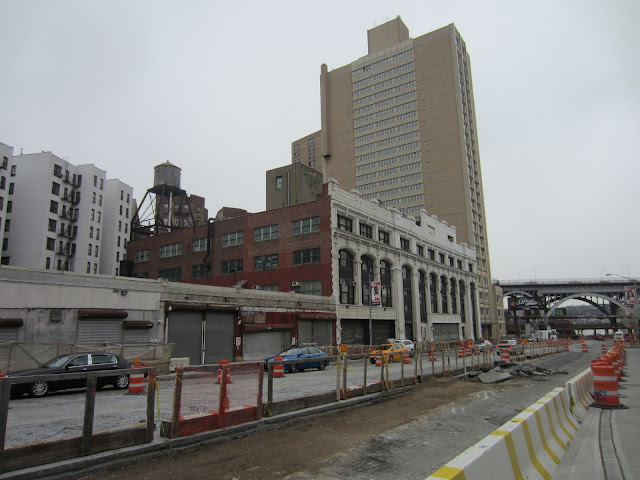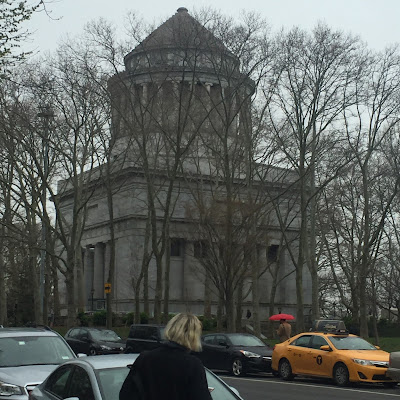We had a spate of gloomy weather while in New York City, but that didn't stop us from doing a lot of walking. NYC is surprisingly walkable. There are many clusters of things to see and great public transportation between clusters.
On a walk around the upper West Side we started out at the northern edge of Columbia University where some of studios for art students are located in an old building that reminded me of a late-19th century department store:
Across the street, a new art building is going up which will provide much better natural lighting for studios:
It would be a shame to lose the old building with its Art Deco touches. I hope it gets remodeled and repurposed:
We made our way towards the Hudson River and the Manhattanville Viaduct via 125th Street:
I love the landscaping that can be found in random spots throughout this massive, crowded city:
These little flower gardens are growing in some of the most expensive dirt in the world:
We headed toward the mausoleum of President Ulysses S. Grant, walking past a beautiful two acre park directly east of the tomb. The park was originally named Claremont Park but was renamed in 1912 after NYC was given a gift of 2,500 cherry blossom trees by Japan. "Sakura" means "cherry blossom." I don't think all 2,500 trees were planted in this little park. We saw more cherry trees in Central Park, and I wonder if some of those trees were part of the 1912 gift.
We were lucky to be there during the bloom season. It was heavenly:
Onward to Grant's Tomb. These days when a U.S. President leaves office, he (and someday she) probably has his (or her) memorial museum/library already underway. In the 19th century, however, no such practice was in place. When Ulysses S. Grant died of throat cancer in 1885, his wife agreed to have his body interred in New York City, in part because that's where Grant lived after he retired, in part because officials offered a spot in Riverside Park in Upper Manhattan, and in part because Julia Grant wanted to continue to live in New York City and wanted her husband's remains nearby. Once he got Julia's consent, the NYC mayor, William Russell Grace, immediately began to raise funds to build a memorial worthy of a President. It was the largest public fundraising effort to date in the U.S., bringing in almost $1 million.
The design was chosen after an international contest, and construction began in 1891. The exterior was finished in 1896, and Grant's body was transferred into an 8.5 ton red granite sarcophagus modeled after the sarcophagus of Napoleon Bonaparte in 1897. Over one million people attended the parade and dedication ceremony.
It is a dignified, imposing structure, very much befitting the Union General during the Civil War and the 16th President of the United States. In fact, it's the largest mausoleum in America:
Two stone eagles salvaged from the demolition of the New York city post office in the 1930s guard the entrance:
The mausoleum was placed under the management of the National Park Service in 1958 and renamed the General Grant National Memorial (although everyone still calls it Grant's Tomb.)
The inside is simple but elegant. There is a soaring central dome reminiscent of the U.S. Capitol and many state capitol buildings:
Directly below the dome and down one level from the visitor entrance are two sarcophagi that hold the bodies of Ulysses and Julia Grant:
A notorious riddle asks, "Who is buried in Grant's Tomb?" The obvious answer is "Grant," but the actual answer is "No one." Technically Grant and his wife aren't buried as their bodies are above ground.
Busts of four other significant Civil War Generals are placed on ledges the lower level facing the tomb, as if mourning or perhaps guarding their Commander-in-Chief. They include General Philip Sheridan and General William Tecumseh Sherman:
. . . General Edward Ord and General George Henry Thomas:
These days it is a liberal Protestant church known for its advocacy on social justice issues.
On April 4, 1967, exactly one year before his assassination, Martin Luther King Jr. delivered his "Riverside Church Speech," also called "Beyond Vietnam," denouncing the war in Vietnam. Some historians believe it was his most controversial speech. Jackie Robinson's funeral was held here in 1972, presided over by the Reverend Jesse Jackson. United Nations Secretary-General Kofi Annan spoke from this pulpit after the September 11, 2001, attacks. Other notable speakers have included Cesar Chavez, Desmond Tutu, Fidel Castro, Nelson Mandela, and Bill Clinton.
On a walk around the upper West Side we started out at the northern edge of Columbia University where some of studios for art students are located in an old building that reminded me of a late-19th century department store:
Across the street, a new art building is going up which will provide much better natural lighting for studios:
It would be a shame to lose the old building with its Art Deco touches. I hope it gets remodeled and repurposed:
We made our way towards the Hudson River and the Manhattanville Viaduct via 125th Street:
I love the landscaping that can be found in random spots throughout this massive, crowded city:
These little flower gardens are growing in some of the most expensive dirt in the world:
We were lucky to be there during the bloom season. It was heavenly:
The design was chosen after an international contest, and construction began in 1891. The exterior was finished in 1896, and Grant's body was transferred into an 8.5 ton red granite sarcophagus modeled after the sarcophagus of Napoleon Bonaparte in 1897. Over one million people attended the parade and dedication ceremony.
It is a dignified, imposing structure, very much befitting the Union General during the Civil War and the 16th President of the United States. In fact, it's the largest mausoleum in America:
Two stone eagles salvaged from the demolition of the New York city post office in the 1930s guard the entrance:
In startling contrast to the austere mausoleum, seventeen Gaudi-esque mosaic benches line the sidewalk approach and wrap around the back of the building. The benches were designed by professional artists and community volunteers. Some of the images are related to Grant, but most are not. Installed in 1972, they have been quite controversial:
The mausoleum was placed under the management of the National Park Service in 1958 and renamed the General Grant National Memorial (although everyone still calls it Grant's Tomb.)
Directly below the dome and down one level from the visitor entrance are two sarcophagi that hold the bodies of Ulysses and Julia Grant:
A notorious riddle asks, "Who is buried in Grant's Tomb?" The obvious answer is "Grant," but the actual answer is "No one." Technically Grant and his wife aren't buried as their bodies are above ground.
Busts of four other significant Civil War Generals are placed on ledges the lower level facing the tomb, as if mourning or perhaps guarding their Commander-in-Chief. They include General Philip Sheridan and General William Tecumseh Sherman:
. . . General Edward Ord and General George Henry Thomas:
The location of the mausoleum at the upper end of Riverside Park really is lovely. The park runs parallel to the Hudson River and is one of the many park oases in the city:
A well-maintained trail winds its way through the vegetation.
A temporary artwork, Sky Feather by Petros Chrisostomou, was installed in Riverside Park when we were there. Its purpose was to draw attention to the robust bird community in the area:
Across the street and a block south of Grant's Tomb is the famous Neo-Gothic Riverside Church, completed in 1930:
This massive church was conceived by industrialist and philanthropist John D. Rockefeller Jr. and minister Henry Emerson Fosdick as an interdenominational place of worship open to all Christians.
These days it is a liberal Protestant church known for its advocacy on social justice issues.
Some important things have happened inside this somewhat spooky, cavernous interior:
 |
| Photo from Wikipedia |
It seems appropriate to end with a few of Fosdick's words. The minister was very quotable.
"A person wrapped up in himself makes a small package."
"He who chooses the beginning of the road chooses the place it leads to. It is the means that determines the end."
"The tragedy of war is that it uses man's best to do man's worst."
"The world is moving so fast these days that the one who says it can't be done is generally interrupted by someone doing it."
"I would rather live in a world where my life is surrounded by mystery than live in a world so small that my mind could comprehend it."
"Some Christians carry their religion on their backs. It is a packet of beliefs and practices which they must bear. At times it grows heavy and they would willingly lay it down, but that would mean a break with old traditions, so they shoulder it again. But real Christians do not carry their religion, their religion carries them. It is not weight, it is wings. It lifts them up, it sees them over hard places. It makes the universe seem friendly, life purposeful, hope real, sacrifice worthwhile. It sets them free from fear, futility, discouragement, and sin--the great enslaver of men's souls."






















































I marvel at your ability to pull together a beautiful post over what seemed, in some respects, such mundane material. In reality it was anything but mundane, and you brought it to life. Very fun facts on Grant's Tomb and the Riverside Church. Just the list of those who have spoken at the church is amazing. And your ability to pick out the little pieces of art and focus on it, incredible. I noticed one of those colorful benches, but didn't give it much mind.
ReplyDeleteI confess, I didn't know Grant's tomb is in NYC. Quite impressive. I'm a little surprised about the "modeled after the sarcophagus of Napoleon Bonaparte" part. I've always considered him a historical figure who was strongly disliked. Kind of like modeling your house or garden after Hitler's.
ReplyDelete